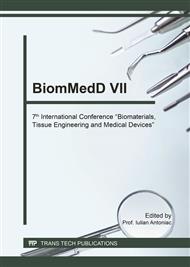[1]
D. Liu, et al., Synthesis of a novel tertiary amine containing urethane domethacrylate monomer (UDTMA) and its application in dental resin, J Mater Sci: Mater Med. 24 (2013) 1595-1603.
DOI: 10.1007/s10856-013-4897-2
Google Scholar
[2]
H. Jingwei, et al., Preparation of antibacterial and radio-opaque dental resin with new polymerizable quaternary ammonium monomer, Dental Materials 31 (2015) 575-582.
DOI: 10.1016/j.dental.2015.02.007
Google Scholar
[3]
L. Andreani, et al., Developmen of Dental Resinous Systems Composed of Bisphenol A Ethoxylated Dimethacrylate and Three Novel Methacrylate Monomers: Synthesis and Characterization, Journal of Applied Polymer Science 128 (2013) 725-734.
DOI: 10.1002/app.38252
Google Scholar
[4]
E. C. Combe, F. J. T. Burke, W. H. Douglas, Dental Biomaterials, Kluwer Academic Publishers, Boston, (1999).
Google Scholar
[5]
H. Qiting, L. Zhenhmei, Preparation and Characterization of Antibacterial Dental Resin with UDMQA-12, Advances in Polymer Technology 32 (2014).
Google Scholar
[6]
H. Jingwei, et al., Preparation and Evaluation of Dental Resin with Antibacterial and Radio-Opaque Function, Int. J. Mol. Sci. 14 (2013) 5445-5460.
Google Scholar
[7]
N. Moszner, U. Salz, Prog. Polym. Sci. 26 (2001).
Google Scholar
[8]
F. Goncalves, et al., Influence of matrix composition on polymerization stress development of experimental composites, Dental Materials 26 (2010) 697-703.
Google Scholar
[9]
C. B. Nail, et al., Properties of methacrylate-thiol-ene formulations as dental restorative materials, Dental Materials 26 (2010) 799-806.
DOI: 10.1016/j.dental.2010.04.005
Google Scholar
[10]
N. B. Cramer, et al., Recent Advances and Developments in Composite Dental Restorative Materials, J Dent Res. 90 (2011) 402-416.
DOI: 10.1177/0022034510381263
Google Scholar
[11]
P. Amit and H.M. Mithra, Dental composites: past, present and future, National Journal of Community Medicine 3 (2012) 754-756.
Google Scholar
[12]
J. He, et al., Synthesis and characterization of a new trimethacrylate monomer with low polymerization shrinkage and its application in dental restoration materials, J Biomater Appl. 25 (2010) 235-249.
DOI: 10.1177/0885328209350088
Google Scholar
[13]
J. He, et al., Synthesis, characterization and photopolymerization of a new dimethacrylate monomer based (alpha-methyl-benzylidene)-bisphenol used as root canal sealer, J Biomater Sci Polym Ed. 21 (2010) 191-205.
DOI: 10.1163/092050609x12471222339166
Google Scholar
[14]
C. M. Chung, Synthesis and photopolymerization of trifunctional methacrylates and their application as dental monomers, J Biomed Mater Res. 62 (2002) 622-627.
DOI: 10.1002/jbm.10359
Google Scholar
[15]
J. G. Kim, et al., Trifunctional methacrylate monomers and their photocured composites with reduced curing shrinkage, water sorption, and water solubility, Biomaterials 24 (2003) 3845-3851.
DOI: 10.1016/s0142-9612(03)00242-4
Google Scholar
[16]
G. K. Saurabh, et al., Release and toxicity of dental resin composite, Toxicology International 19 (2012) 225-234.
Google Scholar
[17]
Y. Biao, et al., Preparatrion and Characterization of Light-Cured Dental Resin without Methacrylate Monomers Derived from Bisphenol A, Advances in Polymer Technology (2014).
DOI: 10.1002/adv.21417
Google Scholar
[18]
J.W. Stansbury and H. S. Dickens, Determination of double bond conversion in a dental resin by near infrared spectroscopy, Dent Mater. 17 (2001) 71-79.
DOI: 10.1016/s0109-5641(00)00062-2
Google Scholar
[19]
T. Buruiana, Buruiana E., Melinte V., Colceriu A., Moldovan M., Urethane dimethacrylate oligomers for dental composite matrix: synthesis and properties, Polymer Engineering and Science, 49(6) (2009) 1127 – 1135.
DOI: 10.1002/pen.21351
Google Scholar
[20]
T. Buruiana, et al., New urethane oligodimethacrylates with quaternary alkylammonium for formulating dental composites, J Mater Sci: Mater Med. 25 (2014) 1183-1194.
DOI: 10.1007/s10856-014-5141-4
Google Scholar
[21]
L. Xiaoxu, et al., Synthesis of Novel Antibacterial Monomers (UDMQA) and Their Potential Application in Dental Resin, Journal of Applied Polymer Science, (2013), DOI: 10. 1002/app. 39113.
Google Scholar
[22]
G. Willems, et al., A classification of dental composites according to their morphological and mechanical characteristics, Dent Mater. 8 (1992) 310-319.
Google Scholar
[23]
G.R. Craig, F.A. Peyton, Elastic and mechanical properties of human dentin, J Dent Res. 37 (1958) 710-718.
DOI: 10.1177/00220345580370041801
Google Scholar
[24]
D.C. Watts, Elastic moduli and viscoelastic relaxation, J Dent. 22 (1994) 154-158.
Google Scholar
[25]
H.H.K. Xu, et al., Indentation damage and mechanical properties of human enamel and dentin, J Dent Res. 77 (1998) 472-480.
DOI: 10.1177/00220345980770030601
Google Scholar
[26]
P. Douglas, et al., Effect of poly ethylene glycol on the mechanical and thermal properties of bioactive poly (ɛ- caprolactone) melt extrudates for pharmaceutical applications, International Journal of Pharmaceutics 500 (2016) 179-186.
DOI: 10.1016/j.ijpharm.2016.01.036
Google Scholar


